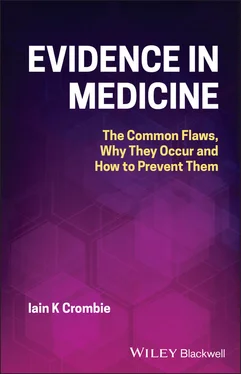Another example of evidence from a series of patients is the discovery of insulin for the treatment of diabetes. This was undoubtedly ‘one of the most dramatic events in the history of the treatment of disease’ [16]. Research, in the late nineteenth century, had shown that removal of an animal's pancreas ‘produced severe and fatal diabetes’ [17]. Over the following 30 years many researchers tried to isolate a pancreatic extract that could control blood sugar levels. They had little success, as the extracts had only a transitory effect on blood sugar and caused unacceptable side effects (vomiting, fever and convulsions) [18, 19]. In October 1920 Frederick Banting, a young Canadian doctor, was preparing a lecture on the pancreas [16]. The research he was reading led him to think that the active ingredient was being destroyed by the digestive enzymes in the pancreas, and that this could be prevented by ligating the pancreatic ducts. Banting began the experiments with extracts of the ligated pancreas in May 1921 [17]. By January 1922 a purified extract had been obtained. This proved successful in treating a 14‐year‐old boy, and in February a further six patients were treated with equally favourable results [16]. The discovery was announced in April to international acclaim; the Nobel prize was awarded to Banting, and one of his colleagues, Dr Macleod, in 1923 [16].
Case series can provide support for a treatment if, as with insulin, the benefits are immediate and substantial. But observations on a set of patients are often not sufficient to identify whether a treatment is truly effective. Consider the management of gunshot wounds in the sixteenth century. At that time it was believed that the bullet introduced poison into the body, and that cauterising the wound with boiling oil mixed with treacle would detoxify it [20, 21]. The treatment was very unpleasant, but was thought to save lives. Force of circumstances led the French barber‐surgeon, Ambroise Paré, to use a different treatment. During the Italian war of 1536–1538, Paré ran out of oil and instead used a balm of egg yolk, rose oil and turpentine [20]. He observed that the outcomes differed substantially between the two groups: those treated with the hot oil were feverish and in ‘great pain and swelling about the edges of their wounds’, whereas those given the balm were resting comfortably [21]. Further trials of the balm convinced Paré that gunshot wounds were not poisoned and should not be cauterised [20].
The comparison of groups also helped promote a technique for the prevention of smallpox. In the 1700s smallpox was a leading cause of death, with many of those who survived suffering disfigurement and blindness [22]. The available preventive measure was to infect children with puss or scab material from smallpox victims, a process known as variolation. Despite reports that it was beneficial [23], there was widespread concern that variolation might carry a greater risk of dying than allowing people to contract the disease naturally. James Jurin evaluated this in the 1720s, by collecting data on death rates in three groups: those who were diagnosed with smallpox, those at risk of contracting smallpox and those who had been variolated [22, 23]. The results appeared convincing with death rates of 16.5% (diagnosed cases), 8.3% (at risk) and 2.0% (variolated) [23]. Preventing smallpox was a much safer practice than letting nature take its course.
Death following childbirth was a serious concern in the seventeenth to nineteenth centuries, causing epidemics ‘of unimaginable proportions’ [24]. A major cause of this mortality, puerperal fever (fever following childbirth), was investigated by Ignaz Semmelweis, a Hungarian doctor. In 1844 he compared the death rates among patients in two wards of a hospital in Vienna. He found that the death rates in a ward staffed by doctors was much higher (16%) than in the one run by midwives (2%) [25]. This, and other observations, led Semmelweis to conclude that the illness was transmitted by doctors coming directly from a post‐mortem to help deliver a baby. He initiated a preventive measure, compulsory hand washing in a chloride of lime solution, which reduced the mortality in the doctors’ ward to 3% [25]. His approach was not popular, because it implied that doctors transmitted disease, and Semmelweis's contract was not renewed. He was finally vindicated some 30 years later when Pasteur identified the bacterium, Streptococcus pyogenes , that caused puerperal fever [25].
These treatment evaluations utilised two different types of comparisons: contemporary controls and historical controls. Contemporary controls are patients who were seen at the same time as those getting the new treatment, but who received the conventional care. Historical controls are patients who had been treated previously in the same location (e.g. hospital). Jurin's comparisons of groups at risk of smallpox, and Semmelweis's comparison of puerperal fever in two wards, used contemporary controls. In contrast the comparison of puerperal fever before and after introducing handwashing, and Paré's comparison of treatments for gunshot wounds, used historical control groups.
The problem with both types of control groups is that there could be systematic differences between the patients in the different groups. Isaac Massey, a contemporary of Jurin, made this criticism of the work on smallpox, pointing out that those who could afford variolation may have been in better health than those in the comparison groups [22]. He concluded that what was needed was groups that were similar, they ‘must and ought to be as near as may be on a Par’ [22].
When groups are similar at baseline, it is more likely that any differences in subsequent outcomes will be due to the differences in the effects of the treatments. The idea of comparing like with like was proposed in the fourteenth century by the poet Francisco Petrarch, who suggested using similar groups of patients to compare the then current treatments with simply letting nature take its course [26].
One way to create similar groups is to recruit a number of patients who are all alike, then give them different treatments. The testing of potential treatments for scurvy is a widely cited example of the benefit of using similar groups. Scurvy is a debilitating and sometimes fatal disease, which afflicted sailors on long‐distance sea voyages from the fifteenth to the nineteenth centuries [27, 28]. By the late 1500s, the benefits of consuming oranges and lemons were well known by Dutch sailors [27], but many English expeditions continued to suffer serious loss of life through scurvy [28]. The issue was still unresolved in 1747 when James Lind, a Royal Navy surgeon, carried out a classic study to assess the effects of six common treatments. He identified 12 sailors with scurvy who were ‘as similar as I could have them’, and tested each of the treatments on groups of 2 men (each pair to receive either: oil of vitriol, vinegar, sea water, cider, oranges and lemons, or a herbal paste) [29]. After 14 days Lind observed ‘the most sudden and visible good effects were perceived from the use of oranges and lemons’. These findings were not widely accepted, and even Lind had doubts about them [29, 30], but the method used reflects an advance in thinking about ways to test treatments. Lind is rightly celebrated for his comparison of like with like in the evaluation of treatments. (In his ‘Treatise of the Scurvy’ Lind does not make any clear recommendations for the treatment of the disease, possibly because he believed that scurvy was not due to poor diet, but was a result of faulty digestion exacerbated by wet weather [29, 30].)
Another study in the eighteenth century used similar groups to assess whether the adverse effects of variolation (to prevent smallpox) could be ameliorated by pretreatment with a compound of mercury. At that time about 1 out of 50 patients vaccinated against smallpox died following the procedure [31]. In 1767 William Watson recruited 31 children who were similar in age, gender and diet [32]. These were divided into three groups, which received either the mercury mixture, a mild senna laxative or no treatment. No clear difference was found between the groups, using an objective measure of assessment (the number of pock marks caused by the variolation). Watson concluded that variolation against smallpox was effective with or without pretreatment with mercury or a mild laxative [32].
Читать дальше












